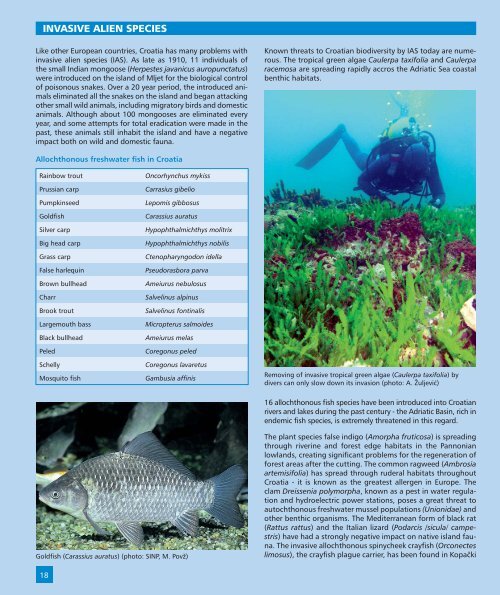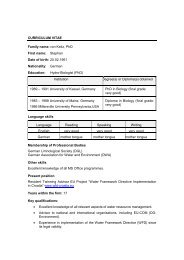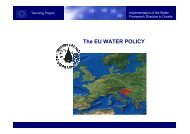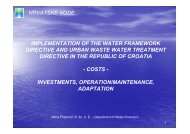BIODIVERSITY OF CROATIA
BIODIVERSITY OF CROATIA
BIODIVERSITY OF CROATIA
You also want an ePaper? Increase the reach of your titles
YUMPU automatically turns print PDFs into web optimized ePapers that Google loves.
INVASIVE ALIEN SPECIES<br />
Like other European countries, Croatia has many problems with<br />
invasive alien species (IAS). As late as 1910, 11 individuals of<br />
the small Indian mongoose (Herpestes javanicus auropunctatus)<br />
were introduced on the island of Mljet for the biological control<br />
of poisonous snakes. Over a 20 year period, the introduced animals<br />
eliminated all the snakes on the island and began attacking<br />
other small wild animals, including migratory birds and domestic<br />
animals. Although about 100 mongooses are eliminated every<br />
year, and some attempts for total eradication were made in the<br />
past, these animals still inhabit the island and have a negative<br />
impact both on wild and domestic fauna.<br />
Known threats to Croatian biodiversity by IAS today are numerous.<br />
The tropical green algae Caulerpa taxifolia and Caulerpa<br />
racemosa are spreading rapidly accros the Adriatic Sea coastal<br />
benthic habitats.<br />
Allochthonous freshwater fish in Croatia<br />
Rainbow trout<br />
Prussian carp<br />
Pumpkinseed<br />
Goldfish<br />
Silver carp<br />
Big head carp<br />
Grass carp<br />
False harlequin<br />
Brown bullhead<br />
Charr<br />
Brook trout<br />
Largemouth bass<br />
Black bullhead<br />
Peled<br />
Schelly<br />
Mosquito fish<br />
Oncorhynchus mykiss<br />
Carrasius gibelio<br />
Lepomis gibbosus<br />
Carassius auratus<br />
Hypophthalmichthys molitrix<br />
Hypophthalmichthys nobilis<br />
Ctenopharyngodon idella<br />
Pseudorasbora parva<br />
Ameiurus nebulosus<br />
Salvelinus alpinus<br />
Salvelinus fontinalis<br />
Micropterus salmoides<br />
Ameiurus melas<br />
Coregonus peled<br />
Coregonus lavaretus<br />
Gambusia affinis<br />
Removing of invasive tropical green algae (Caulerpa taxifolia) by<br />
divers can only slow down its invasion (photo: A. @uljevi})<br />
16 allochthonous fish species have been introduced into Croatian<br />
rivers and lakes during the past century - the Adriatic Basin, rich in<br />
endemic fish species, is extremely threatened in this regard.<br />
Goldfish (Carassius auratus) (photo: SINP, M. Pov`)<br />
The plant species false indigo (Amorpha fruticosa) is spreading<br />
through riverine and forest edge habitats in the Pannonian<br />
lowlands, creating significant problems for the regeneration of<br />
forest areas after the cutting. The common ragweed (Ambrosia<br />
artemisifolia) has spread through ruderal habitats throughout<br />
Croatia - it is known as the greatest allergen in Europe. The<br />
clam Dreissenia polymorpha, known as a pest in water regulation<br />
and hydroelectric power stations, poses a great threat to<br />
autochthonous freshwater mussel populations (Unionidae) and<br />
other benthic organisms. The Mediterranean form of black rat<br />
(Rattus rattus) and the Italian lizard (Podarcis /sicula/ campestris)<br />
have had a strongly negative impact on native island fauna.<br />
The invasive allochthonous spinycheek crayfish (Orconectes<br />
limosus), the crayfish plague carrier, has been found in Kopa~ki<br />
18









